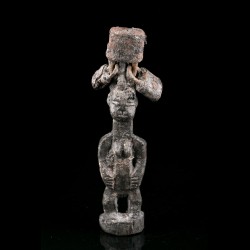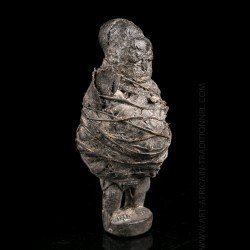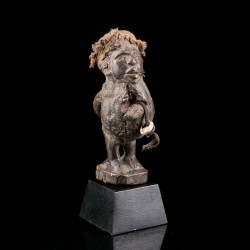













A wooden figure of a female with the entire surface covered in ritual substances. The figure has a round head with small facial features of elongated half closed eyes, small nose, puffy cheeks and small mouth with fleshy lips. To the top of the head the hair is arranged in two crests either side of a conical headdress to which a padlock is attached either side. The thick neck sits on rounded shoulders, below which are the breasts. The body is elongated and flat to the front. The arms hang to the side and are bent at the elbows with the hands either side of the stomach. The short legs are bent at the knees with the feet resting on a small round base.
The Fon people practise a form of African animism known as Vodun. The word Vodun means “spirit” in the Fon and Ewe language, and it is these spirits that form the focus for the ritual practices, acting as intermediaries, in a similar way to the saints of Catholicism. These spirits exist within a hierarchy and are invoked to control the forces of nature and have an influence upon human society. They can inhabit many natural features, such as rocks, hills and streams, as well as being enticed to inhabit a statue such as this which is placed within a Vodun shrine. The use of the padlocks to the top of this figure was a means of literally securing the intention of the supplicant to the spirit during a ceremony.
Data sheet
You might also like

A wooden figure of a female with the entire surface covered in ritual substances. The figure has a round head with small facial features of elongated half closed eyes, small nose, puffy cheeks and small mouth with fleshy lips. To the top of the head the hair is arranged in two crests either side of a conical headdress to which a padlock is attached either side. The thick neck sits on rounded shoulders, below which are the breasts. The body is elongated and flat to the front. The arms hang to the side and are bent at the elbows with the hands either side of the stomach. The short legs are bent at the knees with the feet resting on a small round base.
The Fon people practise a form of African animism known as Vodun. The word Vodun means “spirit” in the Fon and Ewe language, and it is these spirits that form the focus for the ritual practices, acting as intermediaries, in a similar way to the saints of Catholicism. These spirits exist within a hierarchy and are invoked to control the forces of nature and have an influence upon human society. They can inhabit many natural features, such as rocks, hills and streams, as well as being enticed to inhabit a statue such as this which is placed within a Vodun shrine. The use of the padlocks to the top of this figure was a means of literally securing the intention of the supplicant to the spirit during a ceremony.



